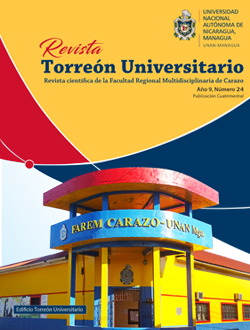Valoración de la eficiencia de remoción de arsénico en agua con carbón activado de jícaro sabanero (Crescentia alata) y su combinación con óxidos de hierro
DOI:
https://doi.org/10.5377/torreon.v9i24.9724Palabras clave:
arsénico, carbón activado, óxidos de hierro, remociónResumen
El arsénico es una de las sustancias químicas más peligrosas en el mundo, según la Organización Mundial de la Salud, por su potencial de producir una serie de enfermedades desde diabetes y anemia hasta cánceres de pulmón y piel, entre otras. Por lo que es muy importante el desarrollar técnicas que permitan su remoción del agua para consumo humano. Este estudio evaluó la eficiencia de remoción de arsénico usando dos medios adsorbentes: carbón activado artesanal y óxidos de hierro en experimentos realizados por duplicado para carbón y por triplicado para el tratamiento secuencial de óxidos de hierro-carbón. Se utilizaron dos tamaños de carbón activado (2 - 4 y 0.6 mm), dos tiempos de contacto (6 y 12 h) y tres concentraciones de trabajo (10, 25 y 50 µg As/L). Los análisis de arsénico remanente en agua se realizaron mediante la metodología estándar internacional de absorción atómica por generación de hidruros. Los mayores porcentajes de remoción de arsénico se obtuvieron aplicando el tratamiento secuencial con óxidos de hierro y carbón activado, 54, 50 y 58 %, respectivamente, para las tres concentraciones tratadas. El análisis de varianza realizado no detectó diferencias significativas entre los resultados obtenidos para 6 y 12 h de contacto, pero sí para los diferentes tamaños de carbón. Por lo que se recomienda usar el tiempo de contacto menor (6 h) y las partículas de carbón de menor tamaño (0.6 mm) para la remoción de Arsénico.
Descargas
920
PDF (English) 222
HTML 395
HTML (English) 187
Citas
Altamirano E, M. (2005). DISTRIBUCIÓN DE LA CONTAMINACIÓN NATURAL POR ARSÉNICO EN LAS AGUAS SUBTERRÁNEAS DE LA SUBCUENCA SUROESTE DEL VALLE DE SEBACO, MATAGALPA-NICARAGUA. Managua: CIRA/UNAN-Managua.
AMEC. (04 de Mayo de 2015). Componentes del filtro para la remoción de Arsénico. AMEC, Managua, Nicaragua.
Amirtharajah, A., & O’Melia, C. (1990). Coagulation processes: Destabilization, mixing and flocculation (4th ed.). (F. W. Pontius, Ed.) Nueva York, N.Y., EE.UU: McGraw-Hill.
DeMarco, M. J., SenGruta, A. K., John, E., & Greenleaf, J. E. (2003). Arsenic removal using a polymeric/inorganic hibrid sorbent. Water Research 37,. 164-176.
Esparza, M. C. (2006). Presencia de arsénico en el agua de bebida en América Latina y su efecto en la salud pública. International Congress: Natural Arsenic in Groundwaters of Latin America. Mexico.
Ferreccio, C., González, C., Milosavjlevic, V., Marshall, G., Sacha, A. M., & Smith, A. H. (2000). Lung cancer and arsenic concentrations in drinking water in Chile. Epidemiology. 11(6). 676-679.
Gregg, S. J., & Sing , S. W. (1982). Adsorption, Surface Area and Porosity. London Academic Press.
Han, B., Runnells, T., & Wickramasinghe, R. (2002). Arsenic renoval from drinking water by flocculation and microfiltration, Desalination 145. 293-298.
Hughes , M. (2002). Arsenic toxicity and potencial mechanisms of action. Toxicology letters. 133,, 1 - 16.
Kapaj, S., Peterson, H., Liber, K., & Bhattacharya, P. (2006). Human Healh Effects from arsenic poisoning-a review. Journal of Environmental Science and Health. Part A 41,. 2399-2428.
Mohan, D., & Pittman, ,. C. (2007). Arsenic removal from water/wastewater using adsorbents-a critical review. Journal of Hazardous Materials 142. 1-53.
Montero Campos, V., Quesada Kimsey, J., Ledezma Espinoza, A., & Sandoval Mora, J. A. (2010). Determinación de arsénico en abastecimientos de agua para consumo humano de la provincia de Cartago, Costa Rica.
Ngai, T. K., Dangol, B., Murcott, S. E., & Shrestha, R. R. (2005). Kanchan Arsenic Filter.Massachusetts Institute of Technology (MIT) and Environment and Public Health Organization (ENPHO). Kathmandu, Nepal. Kathmandu, Nepal.
OMS. (1995). Organizácion Mundial de la Salud.
SMWW. (2005). Standard Methods for the Examination of Water and Wastewater. American Public Healh Association (APHA), 21 .
UNICEF. (2002). MONITOREO Y ATENCIÓN DE INTOXICADOS CON ARSÉNICOEN EL ZAPOTE, MUNICIPIO DE SAN ISIDRO, DEPARTAMENTO DE MATAGALPA, NICARAGUA 1994-2002. Managua: DRA. ALINA GÓMEZ C. Obtenido de https://studylib.es/doc/6457827/monitoreo-y-atenci%C3%B3n-de-intoxicados-con-ars%C3%A9nico-en-el-za.
UNICEF. (2004). Contribución al Estudio de Cinco Zonas Contaminadas Naturalmente por Arsénico en Nicaragua. Managua: UNICEF - Nicaragua.
Universidad Politecnica de Sevilla. (2002). MANUAL DEL CARBON ACTIVO. Recuperado el 2016, de http://www.elaguapotable.com/Manual%20del%20carb%C3%B3n%20activo.pdf
Ures Rodríguez, P., Suárez López, J., & Jácome Burgos, A. (mayo de 2015). ADSORCIÓN EN CARBÓN ACTIVO (FT-TER-002). INDITEX.
USEPA. (2007). Treatment Technologies for Arsenic Removal.
Descargas
Publicado
Cómo citar
Número
Sección
Licencia
Los autores que publican en esta revista están de acuerdo con los siguientes términos.
- El autor o los autores de los artículos, ensayos o investigaciones conceden a la Universidad Nacional Autónoma de Nicaragua, Managua (UNAN-Managua) los derechos de edición (copyright) del trabajo enviado, por consiguiente la Universidad cuenta con el derecho exclusivo para publicar el artículo durante el periodo completo de los derechos de autor.
- Estos derechos de autor/ autores autorizan a la Revista Torreón Universitario y a la Universidad editar y divulgar/publicar el artículo en dicha Revista, incluyendo reproducción impresa y electrónica, el almacenamiento, recuperación y cualquier otro tipo de publicación, y fuentes de información secundaria como servicios de resúmenes y bases de datos, así mismo la facultan a proteger el artículo contra el uso no autorizado para su difusión por medios impresos o electrónicos (PDF, HTML, EPUB, XML u otros).
Licencia para el uso del contenido
La revista hace uso de la Licencia Creative Commons Atribución-NoComercial-SinDerivar 4.0 Internacional.
Bajo esta declaración:

Este revista está sujeta a una licencia de Creative Commons Reconocimiento-NoComercial-SinObraDerivada 4.0 Internacional. Puede ser copiada, distribuida y transmitida públicamente siempre y cuando se cite al autor y la fuente (Revista Torreón Universitario), no debe modificarse ni utilizarse con ningún fin comercial. La licencia completa se puede consultar en http://creativecommons.org/licenses/by-nc-nd/4.0/.



